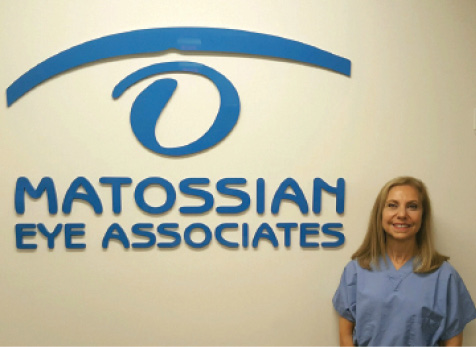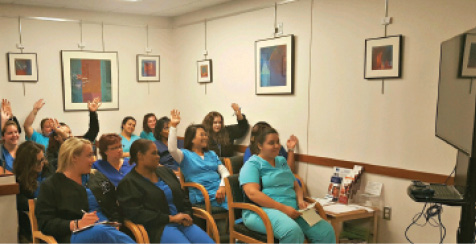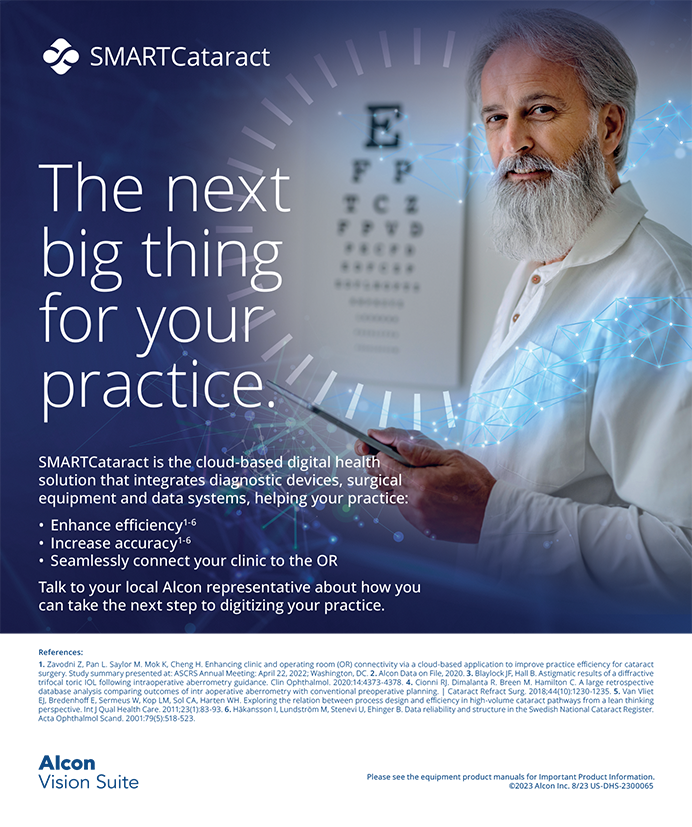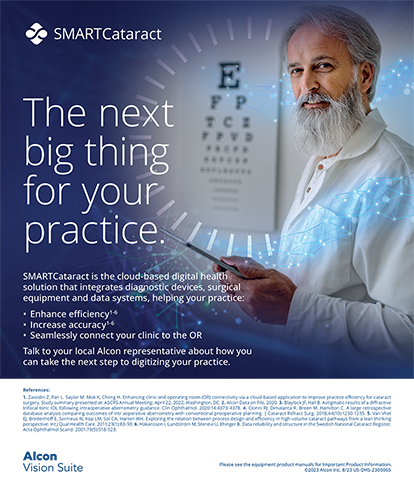
Matossian Eye Associates (MEA) started with one ophthalmologist, one exam lane, one technician, one receptionist, and one goal: patients come first. In 1987, when Medical Director Cynthia Matossian, MD, set out to open her own practice in a traditionally male-dominated specialty, she knew patients’ satisfaction had to be priority number one to adequately gain the trust and loyalty necessary to grow a patient base. What she did not realize was that, despite all of the strides that women had made professionally by the late ’80s, her buying power would be deemed insufficient without the help of a man.

She recalls, “I purchased the ophthalmology section of a practice from two brothers who were retiring and selling their EENT (eyes, ears, nose, and throat) practice. On the closing day, the selling physicians did not acknowledge my signature on the contract, stating that a man had to countersign to make the transaction official and valid. They demanded that my husband countersign the documents, despite the fact that he was not a physician nor an attorney.” She capitulated to that demand and found that she had to work hard to prove to her colleagues that she was competent and could build a successful practice as a female ophthalmologist.
That hard work paid off. Today, the almost 30-year old, vertically integrated, multispecialty practice comprises three facilities in Pennsylvania and New Jersey and employs a staff of 75, including seven ophthalmologists and seven optometrists. “The practice has continued to grow at a steady, healthy pace year after year since its inception,” she says, attributing the progress, in part, to a good old-fashioned work ethic. Dr. Matossian founded MEA after just 1 year as an associate ophthalmologist at someone else’s private practice. “When I launched MEA, initially, I worked every Saturday to make myself available to patients and to the medical community,” she recalls.

RELATIONSHIP BUILDING
Accessibility to patients and relationship building with health care stakeholders throughout the community helped the practice flourish. “I actively worked on building relationships with local internists and family medicine practitioners by visiting them at their offices, and I regularly spoke on eye health at various clubs, organizations, and senior living communities,” explains Dr. Matossian. Facilitating physician lectures to local senior centers and university infirmaries remains a mainstay of the practice’s in-house marketing department.
“Our strategy eschewed advertising in favor of community outreach and the provision of outstanding patient care,” she says, ”and after almost 3 decades, it is clear that our instincts were on point.” Community outreach remains pivotal to the practice’s marketing efforts. Recently, Marketing Coordinator Daniel Rue performed vision screenings at the New Jersey Department of Motor Vehicles to promote eye health and awareness. “These events are a great way to give back to the community and promote eye health,” Dr. Matossian remarks, adding, “Our patients who attend these events are often excited to see us and are proud to have an eye doctor who is involved in their local area.”
The marketing department also manages the practice’s website, blogs, and e-newsletters. It also stays abreast of and involved in social media trends such as online reputation management and search engine optimization, ensuring that MEA is always a lead listing when consumers search for key words such as LASIK, refractive surgery, cataract, glaucoma, cornea, retina, and blepharoplasty.
Watch it Now
Cynthia Matossian, MD, discusses a study she did that investigated possible gender differences in conversion to premium services, including toric IOLs, limbal relaxing incisions, and options for presbyopic correction.
ENGAGING EMPLOYEES
MEA offers a complete range of preventive and corrective eye care, detection and treatment of eye diseases, and eye surgery using the most advanced technology available. “Fellowship-trained specialists in refractive cataract surgery, glaucoma, cornea, retina, and oculoplastics strive to meet our patients’ ocular needs,” explains the surgeon who personally shepherded the practice from its humble beginnings to the model of success that it is today.
She says the practice model is like a triangle with the pinnacle’s being her passion and dedication. It starts at the top, she says, but it is the continuum through the entire staff that supports the practice’s ongoing success. Staff’s education is paramount, and weekly 1-hour training sessions include all departments. “These interactive learning venues help keep staff current while encouraging confidence and leadership. This, in turn, empowers employees to foster more effective teamwork,” she says.
PROFESSIONAL OUTREACH
Connecting with health care providers throughout the community is integral to MEA’s success. The physicians attend hospital networking functions and regularly make one-on-one visits to primary care physicians and optometrists to build and maintain professional relationships. “In addition to these visits, MEA hosts continuing education seminars for area optometrists,” says Dr. Matossian. “This creates opportunities for additional relationship building with the optometric community.”
An important element of nurturing relationships with area optometrists is the choice to stay out of the business of dispensing spectacles. “MEA does not have an optical dispensary,” says Dr. Matossian. “Nor do we have plans to add one; however, we do offer a vast selection of contact lenses, including the most hard-to-fit rigid gas permeable and scleral lenses.” MEA also hosts semiannual educational and networking events for area ophthalmologists.
CLINICAL TRIALS
Establishing a dedicated site for clinical trials and staffing it with a full-time coordinator of clinical studies are also among the strategies that Dr. Matossian believes have been instrumental in the practice’s progress. “MEA has been engaged in a wide array of investigations, from novel intraocular devices to postmarket pharmaceutical products, all with the aim of staying current and providing the most up-to-date technologies and treatments to patients,” says MEA Marketing Supervisor Cait Hutton. “Dr. Matossian recognizes that a productive clinical studies department requires close ongoing collaboration with industry. She works with a wide range of pharmaceutical and ophthalmic device companies and is a speaker and/or consultant for many of these groups through which she has created strong business relationships.”
Select Awards and Accolades
Matossian Eye Associates
• 2016 Healthcare and Pharmaceutical Awards for “Best Multi-Specialty Ophthalmology Practice—Pennsylvania” and “Best Multi-Specialty Ophthalmology Practice—New York Metropolitan Area”
• 2016 Spectrum Award for Excellence in Customer Service
Cynthia Matossian, MD
• 2016 Smart CEO New Jersey Brava Award
• 2016 American Society of Cataract and Refractive Surgery Scientific Paper award by Bausch + Lomb
• One of New Jersey’s Top Doctors (2015) based on peer nomination and review by a physician-led team (Castle Connolly, published by Inside Jersey)
• One of the top 25 female entrepreneurs in New Jersey. She was the only physician among the group (New Jersey Monthly)
• One of the top 50 women in business in Pennsylvania and New Jersey (The Central Penn Business Journal and NJBIZ)
SURVEYS AND WAIT LOSS
MEA places tremendous emphasis on patients’ education through videos, handouts, and personalized online follow-up. “Unless patients fully understand the rationale behind a recommended procedure or the purpose of an implant feature, they do not feel empowered to make an educated, informed decision, especially when out-of-pocket costs are a factor,” says Dr. Matossian, “so providing patient-friendly educational materials every step of the way is critically important.”
MEA also uses surveys to keep the lines of communication open with patients. Surveys are distributed electronically after each encounter, and approximately 10% to 15% generate responses. “The goal is to continually improve the services that MEA provides,” explains Ms. Hutton. A key example of an effective use of the patient surveys emerged after multiple negative comments were made about the overall length of the office visit. “We hired a nationally recognized consultant to evaluate our patient throughput and flow processes, and in response to their findings, we revamped our templates, adjusted appointment slots, and staggered physician start times to address the wait time issues,” says Dr. Matossian. “Since implementing these changes, we have seen a significant drop in survey comments about wait time,” she adds.
Listening to patients also inspired the practice of selling ancillary eye care products. Artificial tears, microwaveable masks, lid scrubs, and omega-3 supplements are among the items available to patients at checkout. “This ensures that the patients get the most appropriate product for their condition,” says Dr. Matossian.
EXCELLENCE IS IN THE DETAILS
MEA’s practice management punch list reads like a road map to excellence. “This practice is a transparent, well-organized business with clear policies and procedures, strategic plans, and systems for follow-through,” says Dr. Matossian. “The overarching commitment to patient care and success in surgical outcomes drives each member of the team.” For example, she explains, “We track surgical outcomes through a variety of methods, including Holladay IOL Consultant Software & Surgical Outcomes Assessment, and we also update our surgically induced astigmatism for each left and right eye, per surgeon, on a quarterly basis.”
The practice also engages in chart audits three to four times per year in an effort to identify billing and coding issues. One of these in-house audits revealed that modifier 59 (distinct procedural service) had to be added to the code “sensory motor evaluation” to receive payment.
When asked what pearls she would like to share with her peers regarding effective methods of operation, Dr. Matossian says, “For any new diagnostic equipment or service to succeed, the practice must have a detailed integration plan with an identified project leader and a realistic timeline.” Given that new technology has always been an integral part of MEA, the practice has integration down to a science. “For example,” she says, “when we integrated ORA Intraoperative Wavefront Aberrometry [Alcon] into MEA, we had 28 separate steps, each of which required a unique action and input from members of the integration team.”
LOOKING AHEAD
A thriving practice cannot rest on its laurels; it has to continually evolve to accommodate ongoing growth. What is ahead for MEA? “We’re expanding the surgical scheduling area at the Hopewell, New Jersey, office and remodeling the reception room to accommodate more seating, even though this office is only 3 years old,” says Dr. Matossian. The marketing and billing areas are also being redesigned, and the clinical studies space is being expanded as well.
The earliest goal of MEA was to put the focus on patients, and while the practice has mushroomed into an entity that bears little resemblance to its shoestring beginnings, its goal, says Dr. Matossian, remains the same: “MEA’s unwavering commitment to provide patients with the best possible care during every encounter has always meant investing in new technologies, getting involved in clinical studies, and continually training staff to exceed patient expectations.” She says this philosophy distinguishes MEA from its competitors, and she believes “the difference is instantly noticeable to patients.”
Rochelle Nataloni
• freelance medical writer with 25 years’ experience specializing in eye care, aesthetics, and practice management
• (856) 401-8859; rochellemedwriter@gmail.com; Twitter @JustRochelleN; www.linkedin.com/in/rochellenataloni



